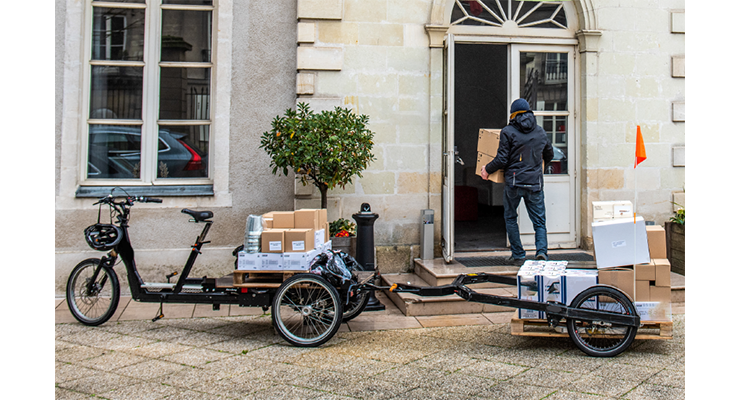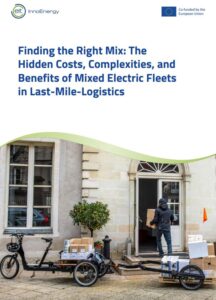Study: Logistics companies could save over half a billion euros annually using mixed electric delivery fleets

A new study by EIT InnoEnergy found that mixed electric fleets of e-cargo bikes and e-vans can save urban logistics providers significant costs compared to a 100% e-van fleet operation and contribute to improving overall life quality in cities.
Cost, operations, sustainability – multiple benefits for logistics providers
The research shows for a large logistics player delivering 2 billion parcels per year with a mixed fleet of 80% e-cargo bikes and 20% e-vans (compared to 100% e-van fleet), the annual cost savings could amount to ~€554M by 2030, while reducing last-mile logistics emissions by up to 80%.[1]
The news comes as logistics companies look to improve margins and reduce CO2 emissions in light of e-commerce driving parcel volume in the European Union up by 8-14% each year.[2] At the same time, regulations such as Stockholm’s upcoming inner city ban on combustion-engine vehicles are creating pressure for logistics operators to decarbonise their last-mile delivery operations.
Given these challenges, the new study addresses an existing knowledge gap in relation to the cost, operational and sustainability impacts of adding e-cargo bikes to the mix, laying out clear comparisons between ICE van fleets, e-van fleets, and mixed fleets.
Jennifer Dungs, Global Head of Mobility at EIT InnoEnergy, says:
E-cargo bikes: cost-effective delivery solution regardless of mix ratio
Findings showed that the use of e-cargo bikes reduces the total cost per parcel compared to e-vans alone, regardless of the fleet mix and the city layout.
In the study’s baseline case, which assumes a delivery fleet with a 60% share of e-cargo bikes and 40% e-vans operating in a large, densely populated city, the total costs per parcel in 2023 would be €0.05 lower compared to a pure e-van fleet (€1.36 vs. €1.41). By 2030, that difference on a per parcel base would increase to €0.20. For a large logistics player delivering 2 billion parcels per year, these cent amounts would translate to bottom line annual savings of around €95M today (2023) and ~€390M by 2030.
In an optimised scenario (80% e-cargo bikes/20% e-vans, operating in a medium-sized city) the savings in relation to a 100% e-van fleet would be even more substantial: €0.08, or 5.3%, less costs per parcel today (2023) would add up to total annual savings of ~€156M for such large logistics provider. That cost difference per parcel would climb to €0.28, or 17.0%, by 2030, equalling total savings of ~€554M.
Importantly, these overall savings in all scenarios occur despite added costs incurred by mixed fleets, which primarily consist of increased personnel costs for parcel sorters at micro fulfilment centres and delivery riders.
Improving overall life quality in cities
Jennifer Dungs adds:
About the study
The complete study, “Finding the Right Mix: The Hidden Costs, Complexities, and Benefits of Mixed Electric Fleets in Last-Mile-Logistics,” is available for download here.
 This bottom-up qualitative and quantitative study was carried out for European markets, utilising data and analytical support from a leading strategy consulting firm combined with insights and data from multiple large courier, express, and package delivery providers (CEP), as well as EIT InnoEnergy portfolio companies and partners. Using these data inputs and quantitative modelling, the study’s calculations provide a comprehensive assessment of the cost and emissions savings from mixed delivery fleets across nearly 40 scenarios mapping different city archetypes, cost impacts and fleet vehicle composition. Three different e-cargo bike and e-van ratios were considered: a baseline case (60% e-cargo bikes/40% e-vans), an optimised case (80% e-cargo bikes/20% e-vans), and a conservative case (30% e-cargo bikes/70% e-vans). These were compared for three different archetypical city layouts – a large, sprawled out city with a large geographical spread (such as Berlin, Madrid, Rome or London); a large, densely populated city with a lower geographical spread (such as Paris, Amsterdam, Barcelona, Stockholm or Vienna); and a medium-sized city with a blend of spread and density. The results and conclusions throughout the study are based on the beforementioned inputs, published sources, expert interviews, and the joint results of the modelling.
This bottom-up qualitative and quantitative study was carried out for European markets, utilising data and analytical support from a leading strategy consulting firm combined with insights and data from multiple large courier, express, and package delivery providers (CEP), as well as EIT InnoEnergy portfolio companies and partners. Using these data inputs and quantitative modelling, the study’s calculations provide a comprehensive assessment of the cost and emissions savings from mixed delivery fleets across nearly 40 scenarios mapping different city archetypes, cost impacts and fleet vehicle composition. Three different e-cargo bike and e-van ratios were considered: a baseline case (60% e-cargo bikes/40% e-vans), an optimised case (80% e-cargo bikes/20% e-vans), and a conservative case (30% e-cargo bikes/70% e-vans). These were compared for three different archetypical city layouts – a large, sprawled out city with a large geographical spread (such as Berlin, Madrid, Rome or London); a large, densely populated city with a lower geographical spread (such as Paris, Amsterdam, Barcelona, Stockholm or Vienna); and a medium-sized city with a blend of spread and density. The results and conclusions throughout the study are based on the beforementioned inputs, published sources, expert interviews, and the joint results of the modelling.
[1] Numbers are rounded.
[2] Based on forecasts by McKinsey, Euromonitor, IMF, and Transport Intelligence.

